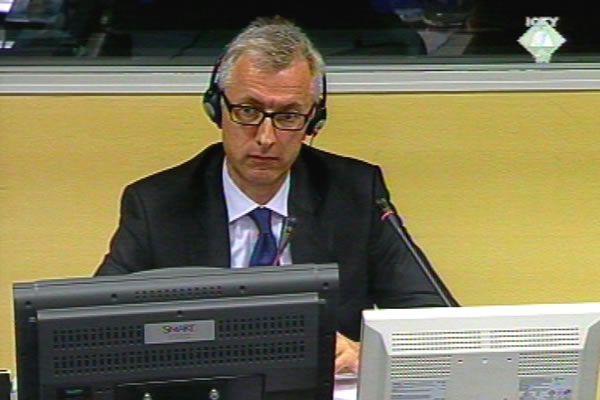Home
DIRECTIVES ISSUED BY ‘CHARISMATIC COMMANDER’
Prosecution military and intelligence expert Reynaud Theunens has explained how Ratko Mladic and the VRS implemented the strategic goals of the Bosnian Serb political leadership. He also spoke about Mladic’s ‘charisma’, about Mladic’s knowledge of events and the investigations of the violations of laws and customs of war
 Reynaud Theunens, witness at the Ratko Mladic trial
Reynaud Theunens, witness at the Ratko Mladic trial At the end of his testimony on Thursday, prosecution military and intelligence analyst Reynaud Theunens said that the former VRS Main Staff commander Ratko Mladic was striving to accomplish the strategic goals set by the Bosnian Serb political leadership in the directives for military actions, from May 1992 to the end of 1995.
In a bid to prove that there was a link between the strategic goals and military actions, the prosecutor showed several documents, including Mladic’s directives. In the first directive issued on 6 June 1992, Mladic orders his troops to launch the operations in the Sarajevo theatre and to cut off the communications between Sarajevo and Trnovo. According to Theunens, this was done to implement the fifth strategic goal, the division of Sarajevo, as well as the second goal, the creation of the Semberija-Krajina corridor. The division of Sarajevo also served to accomplish the first goal, which was to separate the ethnic communities. The text of the directive reflected faithfully the debate at the meeting of the political leadership. The meeting was held on same day when the directive was sent to subordinated units. The prosecutor also showed operational instructions and a combat situation report, because they confirm the immediate implementation of Directive 1.
At the beginning of his testimony, Theunens described Mladic as an active commander who often spent time in the field. Today Theunens explained that Mladic used frequent visits to forward command posts to check the troops’ combat readiness, ‘shorten the lines of communications’ and maintain closer contact with his subordinates. In light of Mladic’s ‘charismatic’ personality, the visits served to further motivate his subordinates.
The prosecutor presented an order of the Visegrad Tactic Group for continued action, dated 11 April 1994. The order relays Mladic’s oral order: ‘Keep pushing energetically onwards, pay no attention to what is going on around us. The Turks must disappear from these areas’. As Theunens explained, this order shows that Mladic was present in a combat zone and that the TG commander considered that Mladic’s oral order should be related to subordinate units. Also, as Theunens said, there were no Turkish troops there; it was a ‘pejorative’ term for Bosniaks.
In his expert report on Mladic’s role as commander Theunens found that ‘to a large extent’ the accused was kept informed about the activities and the situation in the field. If he thought he was not receiving enough information, Mladic issued additional instructions to rectify the situation, Theunens said.
Having examined a series of documents Theunens concluded that Mladic was authorized to order investigations, but used his powers selectively. Mladic focused on infractions and offences that had to do with the implementation of orders. As Theunens claimed, he didn’t see a single document produced by Mladic or the Main Staff that would order an investigation of the violations of laws and customs of war by VRS members. However, Theunens did find VRS documents ordering the investigation of the crimes committed by the enemy soldiers.
Next week, Theunens will be cross-examined by Mladic’s defense.
Linked Reports
- Case : Mladic
- 2013-12-05 STRATEGIC GOALS ACHIEVED UNDER MLADIC’S COMMAND
- 2013-12-03 MLADIC WAS ACTIVE AND INFORMED COMMANDER
- 2013-12-02 ETHNIC DIVISION IN BH
- 2013-12-09 DEFENSE CONTESTS EXPERTISE OF PROSECUTION’S WITNESS
- 2013-12-10 MLADIC’S ‘OSTENSIBLY GOOD INTENTIONS’
- 2013-12-12 BREAK IN RATKO MLADIC’S TRIAL
